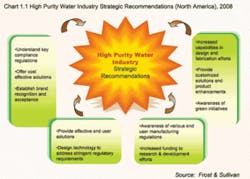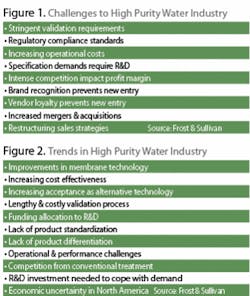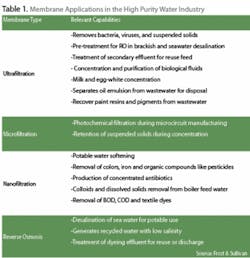High Anxiety for High Purity
by Eric Meliton
• Ultra-pure water market in North America feels sharp impact of global economic downturn, but opportunities for gaining market share still exist – particularly for niche players.
With the growing demands for high purity water for industrial and municipal applications, there are strong growth trends for different technologies within this market segment.
The high purity water industry – also known as the ultra-pure water market – consists of four types of membrane filtration methods:
- Reverse Osmosis (RO) – systems can remove nearly all inorganic contaminants from water.
- Nanofiltration (NF) – systems can be used to process surface waters and remove almost all cysts, bacteria and virus.
- Microfiltration (MF) – systems are ideal for removing suspended particles and bacteria from water.
- Ultrafiltration (UF) – systems are utilized to remove oils, suspended particles and other soluble pollutants.
On a general basis, these four technologies have only reached medium saturation for most industry segments, while significant market growth opportunities are still available within the high purity water industry.
Market Challenges
The high purity water industry is limited by a number of key industry challenges that impact the North American marketplace. These range from stringent regulatory requirements to fluctuating end-user demands. Figure 1 lists current industry challenges as expressed by key market participants, according to recent Frost & Sullivan analysis.
Regulatory compliance standards are the most influential challenges of the high purity water industry. These require a great deal of time, capital, manpower and energy for both the end-users and equipment manufacturers. Regulatory compliance includes levels of validation, documentation standards and equipment design specifications.
For example, the pharmaceutical manufacturing industry is highly regulated. There are official monographs that provide purity guidelines related to the type of water used for drug manufacturing purposes such as the USP 23 Official Monographs for Purified Water and Water for Injection. To adhere to these guidelines, pharmaceutical manufacturers must utilize various water treatment technologies to ensure water used for drug manufacturing is of the highest purity levels.
Market Insight
Despite the challenges that exist in the high purity water industry, there are a number of market trends that promote positive growth in this sector. These trends influence both the general market growth and the overall impact on technology development. Based on Frost & Sullivan industry insights, Figure 2 highlights some of the relevant industry market trends.
Based on the analysis, the ultra-pure water market has a few key industry players. Outside of the major players such as GE Water & Process Technologies, Siemens Water Technologies, Christ Water, and Pall Corp., there are some other players gaining strength within niche sectors of the total marketplace. For example, in the microelectronics industry sector, Nomura Micro Science, Kurita, Wigen Water Technologies, Purewater Solutions, and Ozone Technologies Inc. have growing relevance. Although competition imposed by the larger industry participants is aggressive, these smaller growth firms are expected to gain market share within this industry sector. Similar trends are expected in other industry segments.
One of the most relevant trends in the current marketplace is the immediate impact of the U.S. economic downturn in the latter half of 2008. General market turmoil there has boiled over to affect North American and global participants in the high purity water treatment market.
Currently, speculation abounds on the long-term blow these last few months have had on the global marketplace. Many Tier I manufacturers have remained conservative on estimates related to 2009 research & development and capital expenditure (CAPEX) budgets. This is seen strictly as a short-term reactionary measure to end-user industries and municipalities slowing down related spending on high purity water treatment technology.
Many end-users believe 2009 will be a year of recovery and upside for the whole industry; however, only time will tell if this positive outlook will happen immediately or will be spread out over a span of years.
As for technological trends, improvements to membrane design and specification capabilities combined with enhanced membrane chemistry are the driving trends for technological development. More stringent end-user specifications will play a major role in R&D of advanced membrane technology. Factors becoming more relevant include increasing temperature thresholds, operational costs, longevity, and even environmental factors such as waste disposal needs and energy use.
Price sensitivity also is still a major factor. For example, in traditional industrial markets such as the food and beverage industry, this is quite high, while for the pharmaceutical industry, it's not as influential due to the importance of overall product quality and safety.
In a recent analysis, Frost & Sullivan observed a trend showing a steady decline in CAPEX investment related to treatment equipment amongst the leading U.S. manufacturers. This trend coincided with a move to offshore manufacturing operations in South America and Asia. Despite this, major players of the pharmaceutical industry such as Johnson & Johnson, Pfizer, Novartis, Roche Group and GlaxoSmithKline continue to require advanced high purity treatment technology to adhere to stringent regulatory requirements in North America.
End-User Marketplace
The end-user marketplace is quite diverse. A number of established participants have been using high purity water treatment technology since its inception, along with new end-user segments that have recently begun to apply it to address treatment challenges.
Some major participants include the food and beverage, chemical manufacturing, and pharmaceutical/biotechnology industries.
In addition, many municipalities have invested large sums of CAPEX to incorporate high purity water treatment technology to enhance their treatment systems. Also, UF is often used as a pre-filter step for other membrane products such as RO and is being increasingly used for wastewater treatment for various manufacturing industries via membrane bioreactor (MBR) systems. Table 1 offers a full breakdown of some of the membrane technology applications utilized by various end-user segments.
Conclusion
What are the next steps? According to Frost & Sullivan, there's an opportunity for industry participants to increase their overall market share in the high purity water industry.
Despite the current economic downturn in both the North American and global economies, aggressive Tier I industry participants can further establish their overall market share by being aware of some of these key trends.
About the Author: Eric Meliton is a research analyst with the Palo Alto, CA-based global growth consulting company Frost & Sullivan's North American Environmental & Building Technologies practice. Before this, he was a quality assurance specialist at UPS Supply Chain Solutions. Contact: [email protected] or www.frost.com


